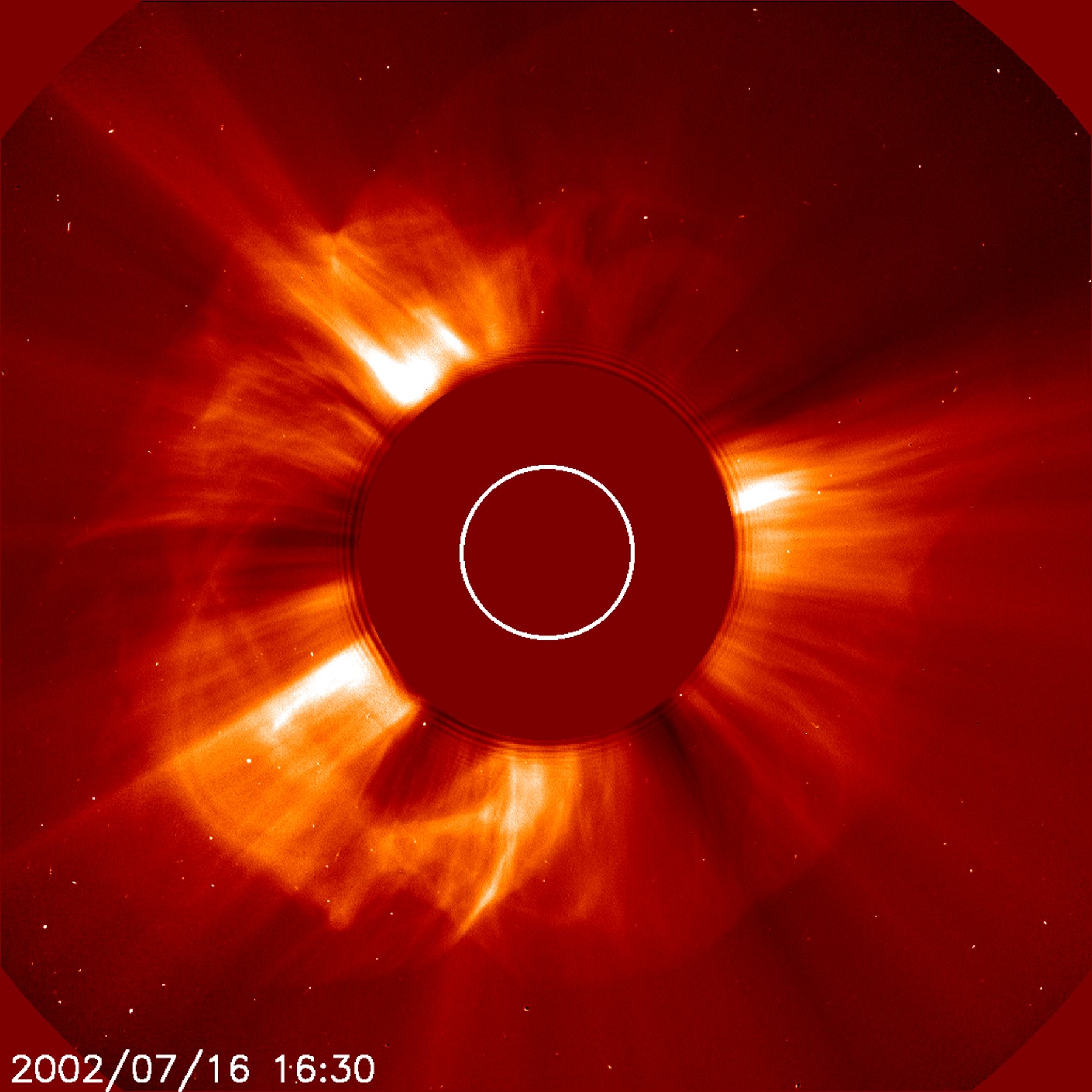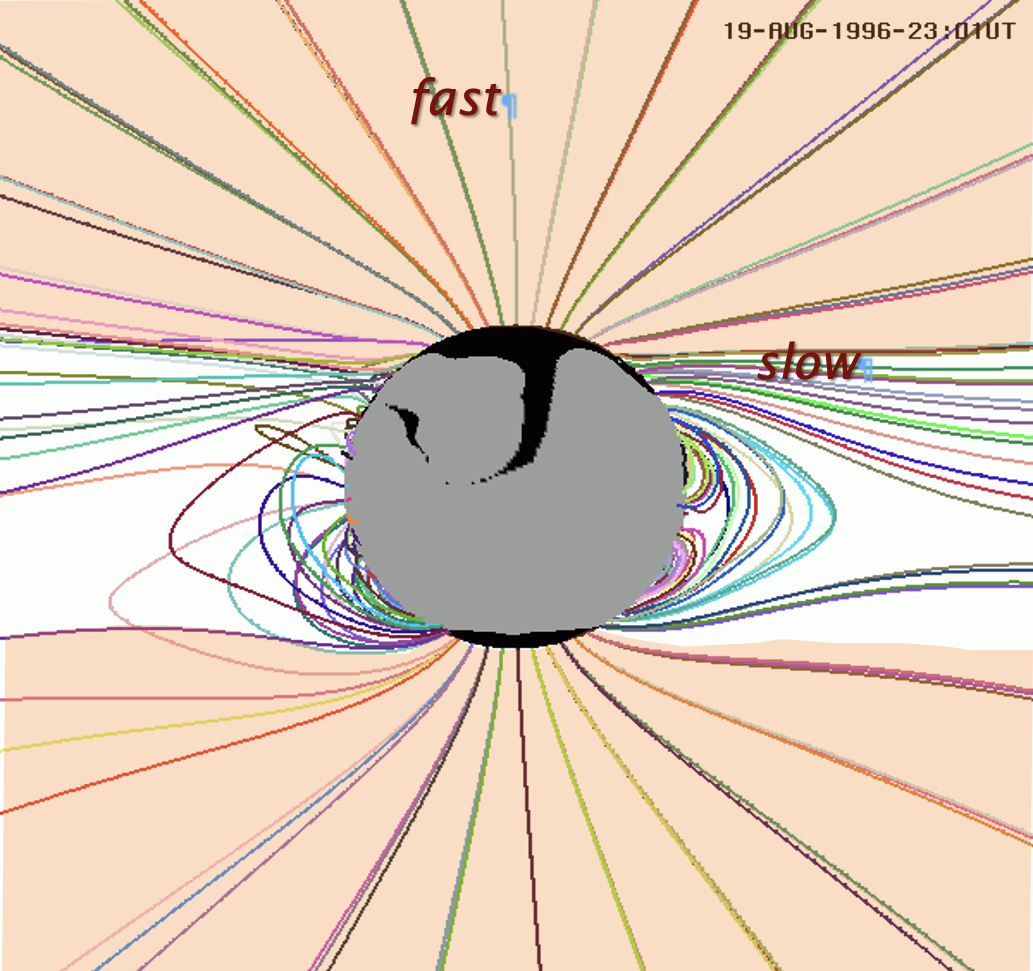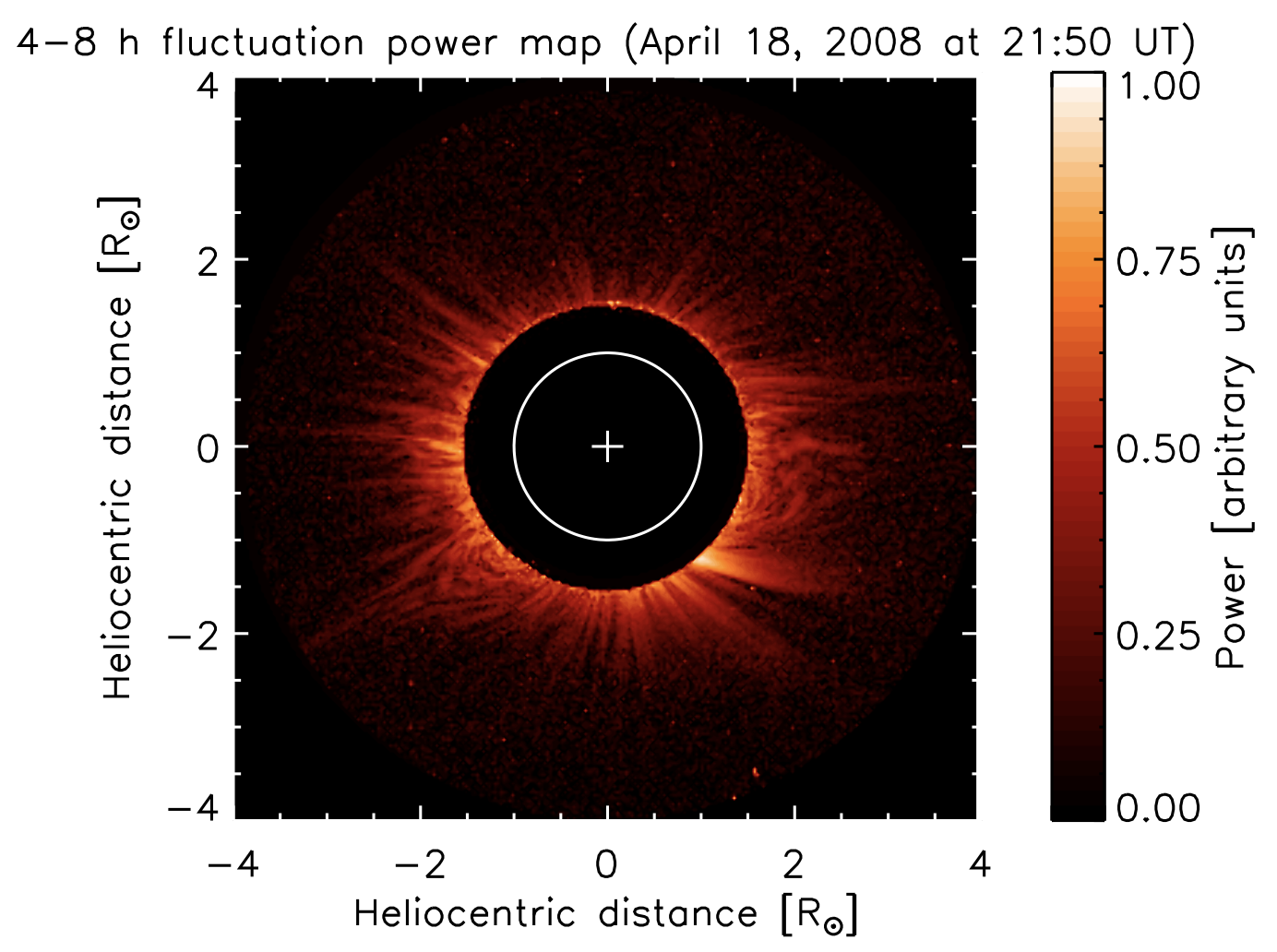Science
Science objectives
Metis observations of the global corona, combined with the observations obtained with the other complementary instruments of Solar Orbiter, allow a throughout investigation of the connections of the heliosphere with its roots on the Sun. More specifically Metis is focused on the exploration of the coronal regions whose continuous expansion generates the solar wind and where the early propagation of sporadic gigantic coronal eruptions is observed.

Spectacular halo coronal mass ejection observed with the LASCO C2 coronagraph (NRL, US) onboard SOHO

Gigantic limb eruption observed with the LASCO C2 coronagraph
Metis objective is to answer the following questions:
- How energy is deposited in the polar regions where the fast solar wind is generated and accelerated?
- Which are the sources of the slow solar wind at lower latitudes?
- How does the global corona evolve and how does give birth to the huge coronal mass ejections characteristic of solar activity?
Metis is designed to uncover the ultimate nature of the power which accelerates the solar wind and of the processes of its deposition in the corona. Further objectives are the understanding of the continuous fluctuations of light emission observed in corona and the assessment of their role in the acceleration of the solar wind in its way toward the interplanetary space. Metis will also assess the influence of the magnetic field on the wind velocity when channeling its flux outwards.
The close-up observations of the solar corona from different perspectives, moreover, is considered essential to comprehending the mechanisms inducing the sudden, gigantic coronal eruptions which accelerate protons and other particles to almost relativistic velocity at their shock front.
Energy deposition and outflows in the expanding corona
In the corona, the emission of the H I Lyman-α line is primarily due to chromospheric photons resonantly scattered by the coronal neutral hydrogen atoms. The radiative emissivity depends on the velocity, with respect to the chromospheric source of radiation, of the coronal volume element absorbing and re-emitting the radiation, owing to the Doppler effect. If the radiation emitted by the source consists of an emission line, in the frame of the absorbing hydrogen atoms the relative velocity causes its center to move away from the center of the absorbing profile. The consequence is a reduced absorption, and therefore a reduced re-emission. Therefore, by measuring this Doppler dimming effect, it is possible to identify the coronal regions where the wind flows and derive the outflow velocity of its neutral hydrogen component.
The global maps of the outflow velocity of the neutral hydrogen/proton component, which will be obtained with Metis observations, provide the wind velocity gradient and thus enable us to identify where and at which rate the energy deposition occurs in the corona.
Role of magnetic field lines in channeling the coronal wind

Fast and slow wind channeled by the magnetic field lines (magnetic field extrapolations Predictive Science)
Metis can outline the magnetic features of the solar atmosphere on the basis of polarized visible light images, and trace the regions where the coronal magnetic field is predominantly open by mapping the coronal plasma outflows in the various wind regimes, thus allowing us to infer the most important features of the solar magnetic topology in terms of connection of the Sun with the heliosphere.
These observations are also crucial to the assessment of the role of magnetic topology in regulating the solar wind speed and properties and thus to test alternative hypotheses on the origin and sources of the fast and slow wind.
Coronal fluctuations and their role in the solar wind acceleration
The Metis coronagraph can also significantly contribute to the understanding of the nature of coronal density fluctuations and assess their role in transferring energy from the inner corona to the regions where the solar wind plasma accelerates. Coronal fluctuations were observed with UVCS in the outer layers of the solar atmosphere: in high-latitude polar coronal holes at ~ 2 R⊙ (solar radii) and in the slow wind, at mid and low latitudes at 1.7 R⊙.
The investigation of the possible connection of these fluctuations, occurring on scales resolvable by the instrument, both with the H I outflow velocity and with the morphology and evolution of the magnetic coronal structures, will provide valuable information for understanding the transfer of energy to the outflowing solar wind plasma.

Map of density fluctuations in the solar corona derived from STEREO data (source: Telloni et al. 2013)
Coronal mass ejection onset and early propagation
A crucial objective of the Metis investigation is that of identifying the mechanism driving the eruption of coronal mass. Coronal mass ejection (CME) events commonly result from an abrupt disruption of the balance between the upward pressure exerted by strongly sheared magnetic fields and the downward pressure, either of magnetic nature or due to the weight of an overlying mass. Limitations inherent to coronal observations have until now prevented the identification of the eruption mechanism leading to a CME.
At perihelia, Metis imaging of the solar corona extends down to 1.7 R⊙. Under these conditions, Metis observations, combined with the overlapping ones obtained with the full disk imager of the Extreme Ultraviolet Imager (EUI) of Solar Orbiter, provide an unprecedented coverage of the region where the eruption and early propagation of the CME occur.
The out-of ecliptic vantage point, later in the mission, offers the opportunity to observe for the first time the corona from midlatitudes and to investigate the longitudinal structure and distribution of the propagating CME plasma.
Eruption of prominences and their propagation in the corona
When the CME activation is associable from an observational point of view with an eruptive prominence, this event can be followed in its development whenever the prominence temperature is relatively low, implying a not-too-high ionisation ratio. During the entire eruptive phase, it will then be possible to evaluate the amount of material moving outwards, and that returning to the solar surface.
Present diagnostic capabilities will be enhanced with the combination of the H I Lyman-α emission measured by Metis, and the He II line intensity obtained with EUI on Solar Orbiter.
Global evolution of the streamer belt
Imaging the corona close to the limb, when the spacecraft is near perihelion and the temporal coverage of coronal features is extended, allows us to monitor the long-term evolution and thus address the physics and evolution of the large-scale corona in response to the evolution of the magnetic field of the Sun, which is changing from a quasi-dipolar configuration at sunspot minimum to a much more complex topology at sunspot maximum.
Out-of-ecliptic observations, in addition, permit investigations of the longitudinal extent of coronal features, and thus the transition of the large-scale coronal structures, projected on the solar equatorial plane, from a slightly warped streamer belt at solar minimum to a more complex configuration when approaching solar maximum.
Acceleration of the solar energetic particles
Understanding the origin of the solar energetic particles (SEPs) and the large variations of their physical properties from one event to another can be achieved by distinguishing flare-accelerated particles from those associated with CMEs, and in the latter case by determining the key parameters of the shocks and their evolution as the mass ejection propagates outward.
Global maps of coronal electron density derived from the polarized visible light images and of the intensity and outflow velocity of the hydrogen corona, both in the pre-CME ambient conditions and during CME propagation, can be combined with radio observations. The joint study of such parameters is essential to identifying the SEP events produced by CMEs, distinguishing them from those caused by the acceleration processes occurring during magnetic reconnection in flares.
In addition, Metis observations allow us to characterise CME-associated shocks as they cross the corona, thus increasing our capability of investigating the mechanisms producing SEPs.